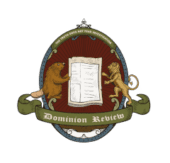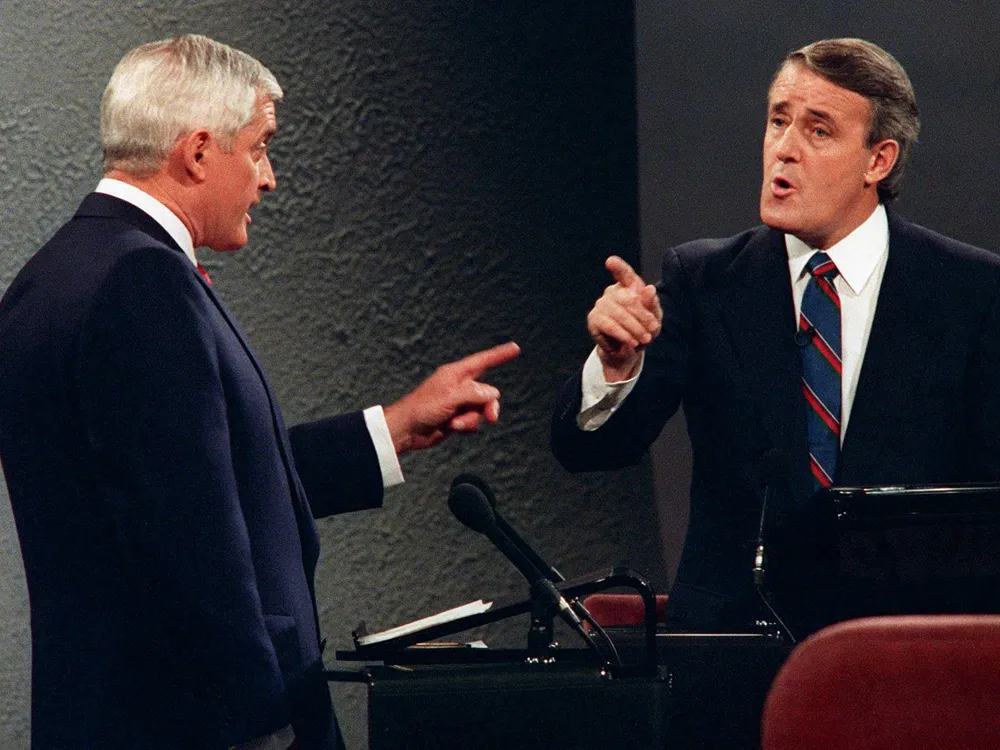“War is Peace, Freedom is Slavery, Ignorance is Strength.” Those are the words written on the Ministry of Truth building against the skyline of Airstrip One in Orwell’s novel 1984. In Ottawa, it seems that a new addition has been made to the fictional motto of the totalitarian Party: “Canada is Multicultural.”
People often assert that 1984 is a book about the nature of totalitarianism, a commentary on dictatorial systems of government like Communism. In certain senses this is true, but when reading the book, I found the most striking aspect to be “doublethink”.
Doublethink is a Newspeak word, Newspeak being the official language of 1984’s Oceania. Essentially, doublethink means cognitive dissonance. However, it is deeper than that. Not only does it involve justifying two contradictory beliefs, it necessitates wholeheartedly dedicating oneself to both simultaneously.
This is demonstrated very early in the book, when the protagonist recites the motto of the Ministry of Truth. The early appearance of the motto, and its flagrant portrayal of doublethink, has led to it being seen as the preeminent demonstration of Orwell’s idea of contradictory thinking.
Despite this, I find that there are much more striking instances of doublethink in 1984. One such instance is a musing that the protagonist Winston Smith makes to himself when reflecting on the history of the Capitalists in England.
The Party of 1984 teaches that the proles were oppressed by the Capitalists:
“They had been starved and flogged, women had been forced to work in the coal mines (women still did work in the coal mines, as a matter of fact), children had been sold into the factories at the age of six. But simultaneously, true to the Principles of doublethink, the Party taught that the proles were natural inferiors who must be kept in subjection, like animals, by the application of a few simple rules.”
In my view, this is the starkest example of doublethink. Members of the Party are expected to feel pity for the proles, and believe that the existence of the State and the Party is for their sake, but all the while – as so tersely stated by Smith’s coworker – they feel that “proles are not human beings”.
In 1984, doublethink goes hand-in-hand with historical revisionism. So much is historical revisionism a prominent feature of the book that Orwell created a main character whose entire job is to rewrite history. The Party’s attitude towards the past is summed up in its famous slogan:
“He who controls the Past controls the Future:
He who controls the Present controls the Past.”
A way in which doublethink and revisionism work in concert is how the members of the Party are supposed to view history. Things today are meant to be infinitely better than yesterday; every quarter, statistics show that all societal metrics are booming. All the while, the status quo of today is the same as how it has always been:

“The past was alterable. The past never had been altered. Oceania was at war with Eastasia. Oceania had always been at war with Eastasia.”
It is this aspect that fits most harmoniously with the manner in which Canadian progressives and the federal government portray Canada’s history. We are inculcated with the idea that Canada has always been Multicultural, and Canada has always been Racist.
The Canadian government ceaselessly attacks the legacies of historical heroes in a way that demonstrates profound doublethink. An example that comes to mind is Sir John A. Macdonald, the Father of Confederation who undoubtedly contributed the most to the formation of this fantastic country.
By all accounts, we should be honouring Macdonald with the highest respect, and yet we find that the government takes every opportunity to slander his memory. Kowtowing to deranged radicals calling for the removal of his statues, renaming streets and institutions christened in his honour, and – most egregiously – defacing his home.
“Unpacking Macdonald” is the name of a tour given at Bellevue House, the home of Sir John A. Macdonald. Opened in May of 2024, it takes every opportunity to defame the famous Prime Minister. One of the architects behind this disgraceful monument to self-hatred exhibits doublethink quite clearly:
“Historic characters appear and speak their truth; modern figures, especially members of the communities most affected by Macdonald’s most unjust legacies, may represent themselves in unexpected ways…”
Here we can see precisely what Winston Smith spoke of in 1984 when he said “He who controls the Present controls the Past.” In the quaint home of our nation’s founder, we are subjected to the blurring of the lines between the past and present.
Is this house a museum meant to show us how Macdonald lived? Or is it a soapbox for modern political virtue signalling? Clearly, the creators of the tour want it to be both.
The new Bellevue House tour attempts to immerse us in the Victorian period in which Macdonald lived, all the while injecting modern progressive politics. It is blatantly trying to blur our understanding of time and dirty the image of our first Prime Minister, by holding him to ridiculous modern standards.
At the reopening of the Bellevue House, speakers from various multicultural ethnic communities were brought in to talk about the racism of John A. Macdonald – Channon Oyeniran of the Ontario Black History Society, Amy Go of the Chinese Canadian National Council For Social Justice, among others. Channon said this in her speech at the reopening ceremony:
“(The Premiership of John A. Macdonald) was also a time when many people of African descent were coming to Canada via the underground railroad… to live freely, create communities, and just live in peace with their families… However Canada, like the United States, was steeped in racism, colonialism, white supremacy and other legacies of enslavement.”
Slavery ended in Canada on the 1st of August, 1834, 33 years prior to the Premiership of Macdonald. That is precisely why the Africans fled to Canada, they were free here – as admitted by Channon.
Canada had no obligation to receive these slaves; ostensibly speaking, they were outlaws in the nation that bordered us directly to our south. Yet we still received them, as part of the worldwide British endeavour to put the final nail in the coffin of slavery. It was by our generosity and humanitarian spirit that we ensured the safety of escaped American slaves.
Ending slavery in Canada should be a point of great pride, and our part in the Imperial fight against slavery should be championed. Yet, according to these ideologues, we should feel ashamed of this period of history when we had taken such strides over all other nations on earth.
Canada was a slavery-free nation for the African Americans to flee to. Canada was a white supremacist dystopia shackled by legacies of enslavement. It’s ludicrous to assert such contradictory ideas without as much as a breath between them. It’s doublethink at its finest!
Conversely, whilst proponents of multiculturalism say that Canada was racist and oppressive, they will turn around and say that every single ethnic group “built” Canada – except old stock Canadians. United Empire Loyalists? Who needs the Lord Dorchester, when there were the Black Loyalists. Nova Scotia was built by Africans. As everybody knows, the Canadian Pacific Railway – John A. Macdonald’s magnum opus – was actually a contribution of the Chinese.
Chinese contributions to the Canadian Pacific Railway is a most belaboured concept. It is frequently said that “For every mile of Canadian railroad built, three Chinese workers died”. In truth, the Canadian Pacific Railway is 12,500 miles long, and only about 600 Chinese workers died out of 17,000 employed. Almost all Chinese labour was exclusive to British Columbia, and was under the administration of the Lian Chang Company.
Working conditions of the Chinese railway workers were equivalent to the European navvies employed on the remainder of the railroad, spanning what would become three separate provinces. The quote about the death toll of Chinese railroad builders so often repeated by multiculturalists originates in a letter by Calgarian homesteader Alex Woods:
“I suppose, dear reader, you think we were a lot of brutes driving other brutes and I suppose we were but by such practices was the west opened up and developed. There was a saying about 60 years ago that in every mile of the grade of the old CPR was the grave of a working stiff. The bad water on the prairie took a heavy toll of life.”
Were the saying to be accurate, given that the Chinese were only employed in the British Columbia segment of the railway, this would still mean that European deaths resulting from the railroad’s construction would be much, much higher.
Stealing the accomplishments of others fits perfectly with the historical revisionism of 1984, in which the Party claims the invention of the helicopter, contrary to the vivid memory of Winston Smith:
“In his own schooldays, Winston remembered, in the late fifties, it was only the helicopter that the Party claimed to have invented; a dozen years later, when Julia was at school, it was already claiming the aeroplane; one generation more, and it would be claiming the steam engine… when he told her that aeroplanes had been in existence before he was born and long before the Revolution, the fact struck her as totally uninteresting.”
While the myth of the Chinese-built railway has pervaded Canadian history for years, we are now seeing the creation of a new legend of the origins of Canada. As I’ve previously covered, despite the fact that Indian immigration to Canada prior to the 21st century was negligible, we’re now being told that Sikhs built Canada. This was asserted directly by Alberta Premier Danielle Smith:
“When the first Sikhs settled in Alberta in the early 1900s, they worked as miners, farmers, and lumber workers. They quite literally built the foundations of our province.”
Or, in the words of the Prime Minister’s Office, which stated in May of 2024: “Sikh Canadians have helped make Canada the country we know and love.”
Then, in the same breath, proponents of multiculturalism will bemoan the Komagata Maru “incident“, when the Canadian government turned away a ship full of political extremists associated with the Gahdarite movement, made up of Indians living abroad who sought to undermine the British Empire.
Our government proclaims that the ‘racist’ policies of our Dominion that prevented Sikhs from coming to Canada were a violation of human rights, and yet asserts that it was those very same Sikhs who were barred from entry that built the country.
The depth of this cognitive dissonance is utterly bewildering to anyone with a critical and plain understanding of history. These two statements are utterly contradictory: either the Canadian government was committing “human rights violations” by turning away Sikhs at the border, or Sikhs were building the country.
Ultimately, however, logical consistency is not the goal of proponents of a multicultural view of Canadian history. To them, truth is whatever makes them feel the warmest and fuzziest inside, or whatever allows them to exploit the most out of special interest groups.
It’s the reason that they “memory-hole” (to use yet another term coined by Orwell) our first Prime Minister, and replace him on our $10 bill with Viola Desmond – a woman very few Canadians know or care about. As said in 1984:
“Statues, inscriptions, memorial stones, the names of streets—anything that might throw light upon the past had been systematically altered.”
This is all about controlling our perception of Canadian history, and of Canadian identity. If we take too much pride in Canada’s past, we may start to notice how Canada is getting worse, and may start to think a little bit more about the government policies responsible for this decline.
Here in Canada, we too have our very own Ministry of Truth. The National Film Board of Canada was once a paragon of Canadiana, with popular Canada Vignettes like the Log Driver’s Waltz, or the Canada Heritage Minutes which instilled pride in our history.
Increasingly, authentic Canadian stories are being suppressed, and replaced with a revisionist and “equitable” vision of a post-national Canada. On the front page of the NFB’s website, you will not see tales of Canadian heroes like James Wolfe, Laura Secord, General Brock, or Colonel Macleod.
Instead, we are subjected to “Latinx-Canadian Cinema”, “Gender Equality and Diversity”, and “Reggae in a Foreign Land”. What exactly is Canadian about these things? Did I miss the chapter in Anne of Green Gables where she talks about the Day of the Dead, or dances to Reggae?
In addition, as highlighted by Lethbridge MP Rachel Thomas in 2021, authentically Canadian content is often ignored by the government. Her example was “Ultimate Gretzky”, a film about Wayne Gretzky, one of the most well known Canadian hockey players of all time. Despite its Canadian theme, it did not meet the CRTC’s definition of “Canadian” content.
Latinx-Canadian Cinema is considered good enough for the NFB, but films about Wayne Gretzky are cast aside by the CRTC. This demonstrates quite clearly that there is a deeply ingrained current of doublethink within the Canadian government.
We are facing a reality in which Canadians don’t know who they are, or how they came to be, while the Canadian government denigrates our history instead of promoting it. Reclaiming our identity will become more and more difficult.
Because in the eyes of our government, Canada has always been Multicultural, Canada has always been Racist.
All content on this website is copyrighted, and cannot be republished or reproduced without permission.
Share this article!




The truth does not fear investigation.
You can help support Dominion Review!
Dominion Review is entirely funded by readers. I am proud to publish hard-hitting columns and in-depth journalism with no paywall, no government grants, and no deference to political correctness and prevailing orthodoxies. If you appreciate this publication and want to help it grow and provide novel and dissenting perspectives to more Canadians, consider subscribing on Patreon for $5/month.
- Riley Donovan, editor